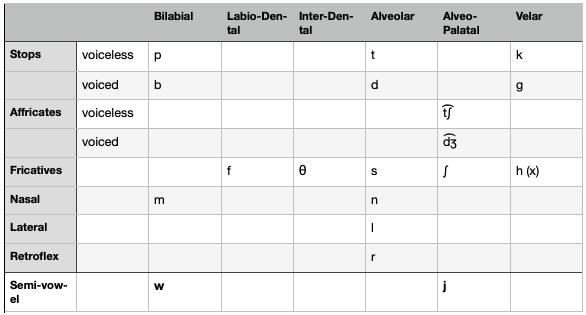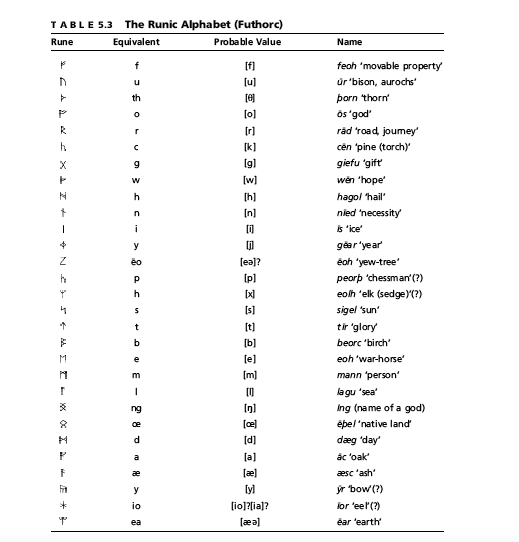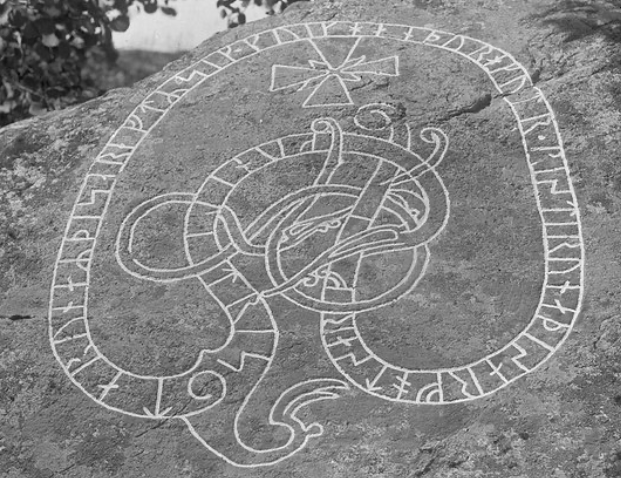Phonology and Orthography

West Germanic Languages Chart By HP1740-B (talk) – I created this work entirely by myself. Based on a commons image released into the public., Public Domain, https://en.wikipedia.org/w/index.php?curid=18146387 Image Number 5
Old English phonology is very complex and information can vary depending on what time period between the fifth to eleventh centuries one is studying, where the materials come from during a time period, and who it was that wrote them. Because no one today speaks Old English anymore, it is difficult to know precisely how it sounded, however if there were folks today who did speak it as their native language they would not all speak in the same vernacular anyhow.
There are some important factors to consider whenever we are speaking of any of the hundreds of Germanic languages that have existed and exist today. All Germanic languages underwent a systemic vowel shift beginning sometime around one thousand B.C. and this shift transpired for several hundred years across all Germanic languages. This is important to know in the context of Old English because these phonological changes affected the Continental language which was brought over to Britain as well as the Norse which the Vikings brought over. There was no one standardized writing system at the time but rather four different English dialects that were represented differently, often according to the individual scribe. The four dialects were Northumbrian, West Saxon, Kentish and Mercian. In modern studies of Old English, it is the West Saxon texts which are used as the standard in phonology and morphology of the language as there were many more items that have survived through the centuries than in the other dialects, penned by people like King Alfred and the monk Ælfric. The West Saxon dialect is not the most common dialect to have morphed over time and which is now spoken today but it is the dialect used for academic purposes of the English language because the most records that exist are in West Saxon..
All of the consonants found in Common Germanic languages were found in Old English. The orthographic representations of some are different than how they are represented today and this will be covered later on.

Table of Old English Consonants in IPA by Alina Fernanda Picayo Image Number 6
Orthographically speaking, in Old English when consonants were doubled up it meant the sound was elongated quite similarly to today’s Italian (bello is /’bel’lo/ ).Today when we write elongated vowels we use macrons (such as ā) but these were not used orthographically. A phoneme of note during the OE period which varied is the letter “g” which was usually pronounced as either [ɣ] or [ʝ] but due to the influence of coming in contact with the Norse language turned into a [g] in certain words as the last letter of words and sometimes in the beginning such as in the word “golden.” All consonants are always pronounced in Old English.
“The Lord’s Prayer” in Old English can be heard here:
Erutuon / CC BY-SA (https://creativecommons.org/licenses/by-sa/4.0)
English vowels are always a problem because all vowels unstable in all languages and it is a matter of biology, a simplistic result of lacking a point of articulation and English vowels are particularly messy ones. The real difference from the Common Germanic to the Old English in the diphthongs. From the Gmc (Germanic) to the OE the /a/ turns into /æ/, /au/ to /ēa/, /eu/ to /ēo/, and /aɪ/ to /ā/. These changes are called front mutation or known as the umlaut as well as i/j mutation. There is a lot of debate about what the Common Germanic vowels actually became during the Old English period as there were four different main dialects spoken at the time in Britain.
Here is a table from A Biography of the English Language, Third Edition by Millward and Hayes on the front mutation of vowels from Common Germanic to the Old English:

Front Mutation Umlaut Millward, C. M., & Hayes, M. (2010). Table 5.2 Front Mutation (Umlaut) [Old English Phonology Front mutation in vowel changes from Gmc to OE]. http://ssu.ac.ir/cms/fileadmin/user_upload/ivfen/ensite/lib/008– Image Number 7
Orthography
For a time there were two different writing systems found on Britannia. Around the time of 700 A.D. when Christian missions began coming to Britain there was a version of the Latin alphabet being used in Britain as well as the runic alphabet, the Futhorc (for the first six sounds in the alphabet) which came from the continental runic alphabet, the Futhark (named for the first six sounds also) by the Nordic people. This runic alphabet eventually spread to all parts of the Anglo-Saxon speaking Britain. At this time there really was no standardized way of writing or spelling and it was up to the scribe. In the Northern parts of England and Scotland a scribe might still be using “ß” (which is still found in German today) and others might not be. At the time even for those scribes that were using a partial romano alphabet there were still graphemes in use that are not used today anymore in Modern English, although languages like Danish and Icelandic continue to use them such as “þ” or the thorn for the digraph “th” representing /t/ or /θ/ depending on where you were from, /æ/ the ash symbol for the vowel in the word “cat”, the edth or ð for /ð/ and /θ/, and the wen (ᚹ) for /w/ sounds.
The Futhorc was so widespread that even among the scribes and monks a sort of creolized writing system had emerged which incorporated some of the current day romano alphabet characters as well as some characters from the Futhorc and it was said that the style of writing very much resembled more the Gaelic writings (after the introduction of Latinized writings) than anything else. The Futhorc may have not stuck around as it was the alphabet of pagan people and there might have been a resistance on the part of the now Christian Anglo-Saxons to incorporate these writings as well as that the Futhorc might have been limited in the phonetic inventory it was capable of incorporating. Runic writings could be written from right to left or left to right as well as as it was a Boustrophedonic system and most of the writings were found on stones, trees, and jewelry but mainly on wood so that the lines carved would go along the grain. Runic alphabets have been in in use up until the last few decades in small communities of Scandinavia but it has fallen into disuse in Modern English.

The Futhorc Runic Alphabet Millward, C. M., & Hayes, M. (1989). Futhorc Runic Alphabet [Runic Alphabet with corresponding phonemes]. http://ssu.ac.ir/cms/fileadmin/user_upload/ivfen/ensite/lib/008-A_Biography_of_the_English_Language__3rd_Edition_C.M._Millward_Mary_Hayes_0495906417_Cengage_.pdf A Biography of the English Language, Millward & Hayes 94 Image Number 8
Comments have been turned off for this Page (see Home for information on Comments).
Edit/Delete this Page from Dashboard > Pages



